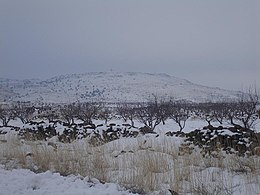
Back جبل حوران Arabic جبل حوران ARZ Cəbəl-Druz Azerbaijani Эд-Друз Byelorussian Ед Друз Bulgarian Djebel al-Druze Catalan Jabal ad Durūz CEB Džabal ad-Durúz Czech Jabal ad Duruz Welsh Dschabal ad-Duruz German
This article includes a list of general references, but it lacks sufficient corresponding inline citations. (May 2016) |
| Part of a series on
Druze |
|---|
 |
| Jabal al-Druze | |
|---|---|
| جبل الدروز (Jabal al-Durūz) | |
 Tell Qeni, the highest peak of Jabal al-Druze | |
| Highest point | |
| Peak | Tell Qeni, As-Suwayda Governorate, Syria |
| Elevation | 1,803 m (5,916 ft) |
| Coordinates | 32°40′N 36°44′E / 32.667°N 36.733°E |
| Naming | |
| Etymology | Named after the Druze people who inhabit the region |
| Native name | جبل الدروز |
| English translation | Mountain of the Druze |
| Geography | |
 | |
| Country | |
| Region | As-Suwayda Governorate |
| Settlement(s) | As-Suwayda, Shahba, Salkhad |
| Parent range | Hauran |
| Biome | Eastern Mediterranean conifer–sclerophyllous–broadleaf forests |
| Geology | |
| Formed by | Volcanism |
| Rock age | Pleistocene to Holocene |
| Mountain type | Volcanic field |
| Rock type | Basalt |
| Volcanic region | Harrat al-Sham |
| Last eruption | Holocene |
Jabal al-Druze (Arabic: جبل الدروز, romanized: jabal al-durūz, lit. 'Mountain of the Druze'), is an elevated volcanic region in the As-Suwayda Governorate of southern Syria.[1] Most of the inhabitants of this region are Druze, and there are also significant Christian communities.[2][3] Safaitic inscriptions were first found in this area. The State of Jabal Druze was an autonomous area in the French Mandate for Syria and the Lebanon from 1921 to 1936.[4][5] In the past, the name Jabal al-Druze was used for a different area, located in Mount Lebanon.[citation needed]
In Syria, most Druze reside in the As-Suwayda Governorate, which encompasses almost all of Jabal al-Druze. This governorate is unique in Syria as it has a Druze majority. Additionally, it has integrated Christian communities that have long coexisted harmoniously with the Druze in these mountains.[6]
In the 1980s Druze made up 87.6% of the population, Christians (mostly Greek Orthodox) 11% and Sunni Muslims 2%.[7] In 2010, the As-Suwayda governorate has a population of about 375,000 inhabitants, Druze made up 90%, Christians 7% and Sunni Muslims 3%.[2] Due to low birth and high emigration rates, Christians proportion in As-Suwayda had declined.[2]
- ^ "Mount al-Durūz | Lebanon, Anti-Lebanon Range, Summit | Britannica". www.britannica.com. Retrieved 2024-07-22.
- ^ a b c The Druze and Assad: Strategic Bedfellows
- ^ "Christians in Syria's Suwayda discuss history, coexistence with Druze majority". North Press. 18 September 2020.
- ^ "11. French Syria (1919-1946)". uca.edu. Retrieved 2024-07-22.
- ^ "French Mandate for Syria and the Lebanon". The American Journal of International Law. 17 (3): 177–182. 1923. doi:10.2307/2212963. ISSN 0002-9300. JSTOR 2212963.
- ^ Balanche, Fabrice (2017). Atlas of the Near East: State Formation and the Arab-Israeli Conflict, 1918–2010. Brill. p. 27. ISBN 9789004345188.
...comprised 50,328 inhabitants, of whom 85 per cent were Druze, and it integrated Christian communities (7,000 people) who had long lived in these mountains in harmony with the Druze.
- ^ Pipes, Daniel (1990). Greater Syria: The History of an Ambition. Oxford University Press. p. 151. ISBN 978-0-19-506021-8.
